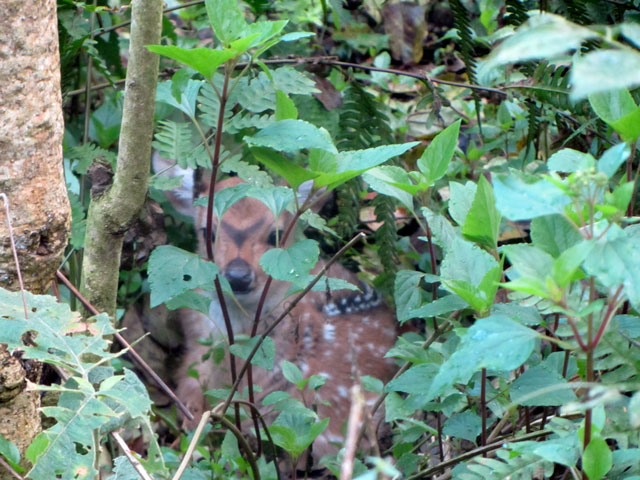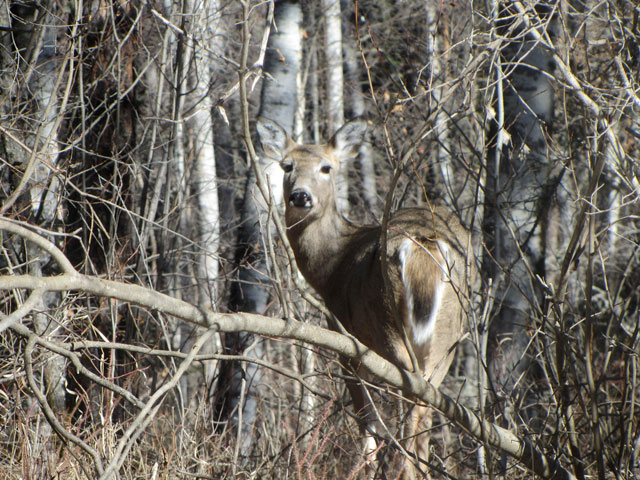What to do if you find an injured deer or abandoned fawn.
Fawns:
DO NOT PICK UP FAWNS!!
A Mother Doe uses the “benign neglect” survival strategy for her young. She leaves them alone all day, returning periodically throughout the day to feed them. They have no scent, and will stay very still if disturbed. Thus a predator will walk right by them, and not be aware of their presence in the bush.

These fawns are NOT abandoned. Their Mother is nearby.
If you are worried or concerned that the fawn is thin, shaking, bleeding, crying, or has been there for more than 24 hours, then call LSWR at (306) 281-0554. A volunteer will assist you in determining what to do.
Fawns have been successfully reunited with their mothers even after 24 hours apart.This is particularly important information for those well-meaning people who see a fawn and take it home, believing it to be abandoned.
Natural History of Deer:
We have both White-tailed and Mule deer in Saskatchewan. “White-tailed” refers to the distinctive white tail that when raised is a flag and provides a flash of white, signaling other deer when there is danger. The Mule deer has a white tail with a black tip that it carries in the drooped position. The Mule deer’s large ears are able to move constantly and independently from each other and are the namesake of this Cervidae (deer family).
White-tailed deer are graceful and swift runners (up to 35 miles per hour), but do not generally run long distances, preferring to seek the nearest shelter whenever possible. Instead of running, the Mule deer jumps stiff-legged with all four feet hitting the ground at once. It can leap distances up to eight yards and reach speeds up to forty-five miles per hour. This style of leaping is called stotting.
Male deer are called “bucks”, females “does” and baby deer “fawns”. White-tailed deer tend to live in female-led family groups of up to 25 deer and may live to ten years or more. Some captive Mule deer lived up to 25 years.
The Mule deer is generally four to six-and-a-half feet in length and three to three-and-a-half feet high at the shoulder. White-tailed deer sizes range between 125 to 225 pounds, although really healthy bucks may be even larger. Their coats are a reddish-brown color in the summer, but becomes much more gray in the winter. This change helps to hide them as the colors of their environment change. Deer have tubular or hollow hairs that provide insulation, allowing them to lie on snow without melting it, as well as creating enough buoyancy for swimming.
White-tailed deer extend from the southern edge of the arctic prairies in Canada, all the way to the northern bank of the Amazon River. Mule deer live throughout western North America from the southern Yukon to northern Mexico, including the deserts of the US.
Males and occasionally females have antlers, which are made from bone and are shed annually, usually mid-winter (new ones are grown in the spring). It may be surprising then that antlers are rarely found in the woods. Since they are rich in calcium and other nutrients, antlers are usually eaten by animals such as porcupines, rabbits and rodents soon after they are shed. Although older bucks generally do have larger antlers, the size and number of points of a buck’s antlers are primarily dependent upon the amount of nutrients, vitamins and minerals in the deer’s diet, not their age.
Bucks do not use their antlers as protection from predators. Mostly, they protect themselves by rearing up and slashing out with their front hooves. Instead, they use their antlers to establish dominance over other bucks in a forceful pushing and shoving match. Only the strongest and most dominant males have an opportunity to mate from fall through the middle of the winter. A buck knows how big his “rack” is by scraping it against a tree, thus giving him a sense of his “size”, since there are no mirrors to look into.
Deer have a good sense of smell, keen hearing and eyesight, but they are color blind, which is why they may not notice humans dressed in “hunter orange.” They forage on a wide variety of plant materials, including twigs, fungi, and shoots. Mule deer can locate water with their keen sense of smell and use their large feet to claw water out of the ground from as much as two feet deep.
Unlike many of our native species, the White-tailed deer has flourished because of its ability to adapt to disturbed areas, alteration of forest habitat, and our hodgepodge of land use practices. Deer use a wide variety of habitat types. Even in dunes, which are not usually thought of as deer habitat, deer are common summer residents. Although they do not migrate, deer shift between winter and summer ranges during the year.
Deer are a vital prey species for larger predators such as wolves, coyotes, cougars and scavengers (foxes, ravens, etc). This is especially true in winter when other sources of food have disappeared, including fruits and berries that supplement diets in the summer.
Deer are ruminants, like cows and have four stomachs. In the first stomach, called the rumen, microorganisms break down plant tissue. Like cows, deer will occasionally regurgitate food and “chew their cud” to aid in the breakdown of food particles. The remaining three stomachs complete the digestion process.
Fawns are usually born in late May and into June. A doe can give birth to one, two or three fawns. Fawns can stand and walk within 20 minutes of birth. Fawns are born a reddish-brown colour with white spots, which provides excellent camouflage when they are lying on the ground. Newborn fawns also have no scent. These two key elements, (camouflage and lack of scent) protect them from predators in the critical early days of life.
They spend much of their time in the first two weeks lying quietly, waiting for the doe to return to nurse. Does leave their fawns alone for the majority of the day. This behavior ensures she does not draw attention to the fawn. Twin or triplet fawns are often not together. The doe returns to nurse the fawns briefly (for a few minutes) several times a day but quickly leaves again. The doe is generally within hearing distance of the fawns.
Mule deer will respond quickly to a bawling fawn but studies in Alberta have suggested that White-tailed deer may not respond or have shown a weak response to a bawling fawn. White-tailed deer are known to be extremely skittish and will not show themselves to humans even if their fawn is being picked up and is bawling. Fawns are not able to really run well to evade predators until they are about two weeks or more of age. Until then, their in-born response to threat is to “freeze” and remain still.
Fawns have been successfully reunited with their mothers even after 24 hours apart. This is particularly important information for those well-meaning people who see a fawn and take it home, believing it to be abandoned. They should be returned to where they were found as soon as possible. Deer are wary of human smells, so if the fawn was handled, it must be rubbed down with an old towel that was rubbed in the grass. This should be sufficient to remove the human scent.
It is very important to leave the fawn alone unless you have clear evidence that the doe is dead. (i.e. there is a corpse on the road), or the fawn is showing signs of distress, bleeding, shivering, obvious broken limb, or other distinct injury.
Deer do very poorly in captivity. They habituate to people quite easily, especially given the lengthy time to raise them on a milk formula. These “rehabilitated” deer have now lost their fear of humans, leaving them vulnerable to hunters. This is a distinct disadvantage to their survival. In addition, the males can pose a significant danger to people as they become quite aggressive in breeding season, and will attack people in the absence of healthy fear. Often, they need to be euthanized at that time. So, it may be cute and may Look abandoned, but that little fawn is just trying to stay hidden and should not be disturbed at all.



